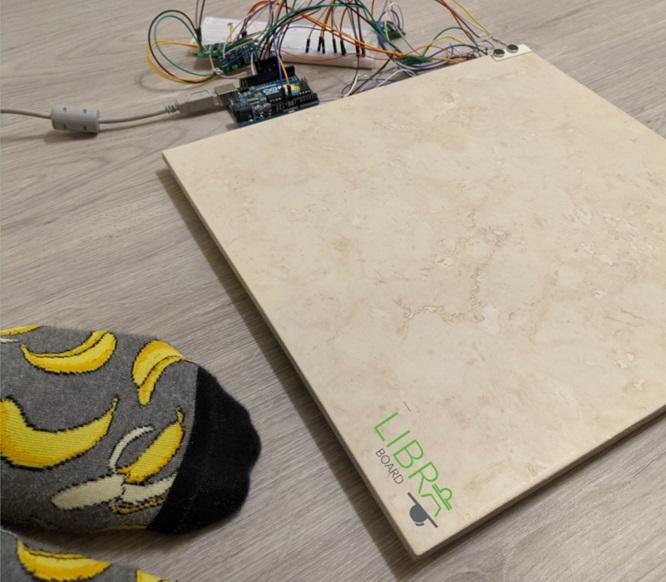Jan. 15, 2021
Keeping seniors steady wins students $10,000 at competition

A fall at any age can be dangerous, but for those over 65 it can mean losing the ability to do everyday tasks and, at worst, losing independence. The key to preventing a fall is to maintain good balance, and a group of seven students from various disciplines worked together to create a balance board specifically made with seniors in mind. Their new product — which is also gamified — is called LibraBoard, and it has earned them $10,000 at the Neuro Nexus 2020 Hack-a-thon.
“We had to conduct a lot of our work over Zoom, but we managed to create a board that has features that other boards on the market do not have,” says Joice El Mehallawy, a kinesiology student who was on the winning team. This is the second time El Mehallawy has been on a team to win $10,000 — she also competed in the Innovation 4 Health competition last year.
The other LibraBoard team members are Resha Mau, Alhamd Khan, Michael Francis, Clara Tapia, Joice El Mehallawy and Anna Bourgeois from UCalgary, and Portia Rayner from the University of Alberta.
- Photo above: The LibraBoard team in a virtual meeting. Top, from left: Michael Francis, Clara Tapia, Anna Bourgeois Middle, from left: Portia Rayner, Joice El Mehallawy, Alhamd Khan. Bottom: Resha Mau.
For the competition, students form a group to solve a real-life challenge in brain science and mental health brought to them by people such as clinicians and company representatives. They have six weeks to design a solution, which includes creating and marketing a prototype. It wraps up with each group making a pitch for their final product.
More than $80,000 in awards is available across three categories: Industry, Research and Entrepreneurial. The LibraBoard team won in the Industry category.
The challenge the LibraBoard team was given was to create a low-cost, portable, balance training and assessment device. They chose to create a device for those over 65, as improving the balance of seniors can have an immense impact. In Canada, one in six people is over the age of 65, and a third of them will have a fall. Falls cost Alberta’s health-care system $288 million per year and Canada’s health-care system more than $2 billion.
“Solving real-life challenges can give you an experience like no other," says El-Mehallawy. "You meet new people from other disciplines, and they give you new perspectives on how to approach the task."
Creating the perfect balance board
As part of the project, the students interviewed physiotherapists to gain a better understanding of the consequences of poor balance, and to find ways to improve upon other products currently on the market.
“By interviewing physiotherapists, we learned that current boards are either too expensive or too intense to meet the needs of the aging population, which leads to poor compliance,” says Bourgeois. “We also learned many balance boards are too high off the ground, making them dangerous for seniors. This is why we made ours very close to the ground.”
The team also wanted to make the board fun to use and they gamified it. It plugs into a television and participants stand as still as possible on the board and get real-time feedback on their ability to maintain balance. They also have the option to move side-to-side and avoid cars on the screen, a task which improves their balance by strengthening their core muscles.
Physiotherapists also expressed a need for a balance board that was able to objectively measure and track balance and other research-based outcomes. To get help with this, the team approached researcher Dr. Ryan Peters, PhD, in the Faculty of Kinesiology and member of the Hotchkiss Brain Institute at the Cumming School of Medicine.
Peters and his company Vibratus Inc. use wearable technology that emits vibrations to quickly and easily test nerve function.
“It was clear to me that Vibratus’s technologies would be well-suited for balance board applications," says Peters. "We discussed the great potential here and the LibraBoard team ran with it. I’m very proud of what they have accomplished."
The students applied the vibration technology to their balance board, making it the first to incorporate such technology.
“Our board has an extra edge because the vibrations we integrated provides the user’s nervous system with an extra boost to help them detect important signals. This helps them to adjust their posture and therefore decreases the risk of falls,” says Bourgeois.

Balance board prototype LibraBoard created by the team.
The board is also able to generate a report to provide the health-care provider with feedback on how well their patient is progressing toward improving their balance. This enables the health-care provider to better tailor their client's rehabilitation program.
“We’ve had physiotherapists tell us they would use this technology if it was available commercially. It would also be helpful for places like assisted living facilities. Residents could use the board to improve their balance and reduce falls,” says Bourgeois.
This is Bourgeois’s first competition, and she highly recommends it for other students.
“With this project I’ve gained a deep understanding about the importance of good balance. Now I know it’s a multifaceted and complex issue, and one worth solving.”
All members of the team will work with HealthTech Connex, the group that originally presented them the challenge, on a four-month internship to continue to work on the project.
Neuro Nexus is a multidisciplinary design competition that aims to bridge the gap between disciplines, accelerate research, and improve the translation of new ideas to impact neuroscience and mental health.
The University of Calgary’s multidisciplinary Engineering Solutions for Health: Biomedical Engineering research strategy drives solutions to our most pressing health challenges in disease and injury prevention, diagnosis, and treatments. Our biomedical engineering researchers make a significant impact in our communities by extending lives, improving quality of life, promoting independence, and continuously improving the health system.






